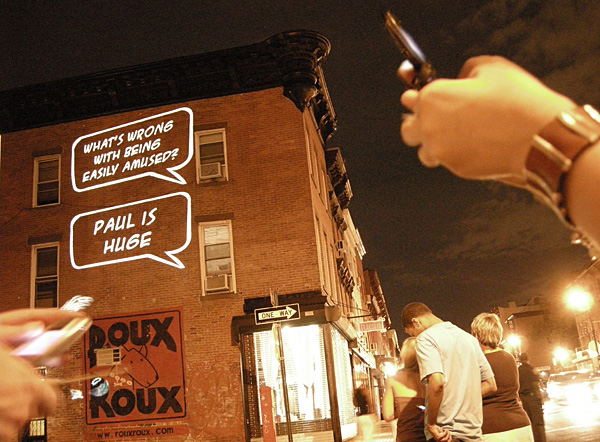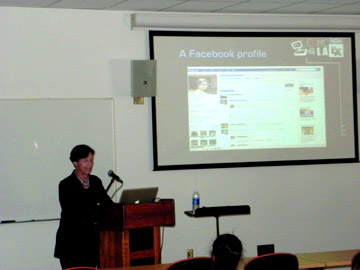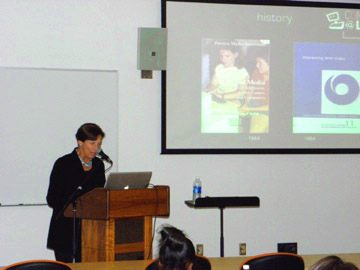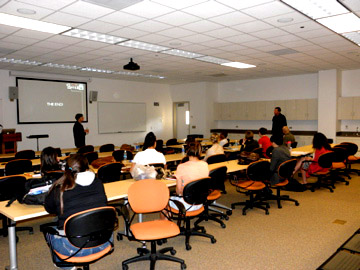Posts from the ‘event archive post’ Category
Event Archive: Rethinking Debates on Digital Learning . 12 Feb 2014
February 13th, 2014
Steve Anderson
Yesterday CDH sponsored a talk by Professor Juliette Levy of the Department of History at UC Riverside. In her discussion, Professor Levy described her own evolution toward using digital technology in order to broaden the learning experience for her students.
Professor Levy’s talk began with a common experience many in academia have shared — traditional methods of teaching are not being adapted to the changing needs of students in our modern world.
The RSA talk by Sir Ken Robinson, which was turned into an animated video, was central to describing this need for change. There is a great chasm between the needs of students and the pace of innovation within the classroom.
Central to this movement toward digital learning in the traditional classroom is the need to meet students “where they are” with digital technology. The call for action is not to expand the technological savvy of the students, but to leverage their preexisting familiarity with digital culture and devices in order to expand the classroom experience.
Harnessing the digital skills of students can extend the learning experience outside of the classroom walls, and it can also create more collaboration between the students themselves. For example, every student may not have a smartphone, tablet, or laptop, but many do. Sharing these devices and skills during group exercises can help students get to know each other, while at the same time thickening the learning experience.
Most interaction with technology in the classroom is with a Learning Management System or LMS, like Blackboard or Canvas. These LMS systems are very necessary for grades, enrollment, and automated exercises like quizzes. The key, however, is to move beyond the reliance on the LMS, which was designed to assign, control, automate, and distribute information, and experiment with more decentralized and multi-nodal methods of digital interaction. Decentralized digital platforms like Twitter and Piazza allow for traditional academic hierarchies to be broken-down and remixed in new ways that are rewarding for students and professors alike.
A few key points from the talk:
1. Model the behavior.
Modeling the behavior, such as live-tweeting lectures, will help instructors to retain a sense authority while also allowing for more flexible pathways of interaction. Also, modeling provides students with concrete examples of what digital technologies are available, and also how to use them professionally. Teaching assistants can begin processes like these with Twitter, or tweets can be scheduled to automatically post during the lecture. Students should be encouraged to tweet also, in order to gradually take over the entire note-taking and note-sharing process.
2. Incentives and risks.
Some incentives and risks are set by the professor through the syllabus in an explicit fashion, such as attendance or exam dates. Other incentives and risks are more subtle, but they can also be very powerful and possibly limiting. For example, it’s difficult to harness the technical prowess of students if they are not allowed to use digital devices in the classroom. Of course some students might be inclined to wander off into the far reaches of the Internet, but they should be redirected toward more fruitful material rather than completely restricted.
3. Experiment and innovate.
A sense of experimentation in the classroom can also lead to a sense of excitement. Involving students in the process of the course through polls on Piazza, for example, can foster a sense of student empowerment. Also, if students are aware that the professor is experimenting with pedagogy, they’re also more likely to push the boundaries of the assignments in positive ways. Many students are afraid to take risks academically for fear of failing, and a sense of experimentation in the class can help relieve that pressure.
All in all, Professor Levy made it clear that she is not advocating for building larger lecture halls, or relying on MOOCs to educate the masses. Instead, she calls for the directed application of digital technology in order to expand the traditional classroom experience with the consideration and participation of the students themselves.

The final invited talk of the 2011-2012 Critical Digital season was presented by Dr. Rita Raley from theEnglish department at UC Santa Barbara. Dr. Raley presented a paper that addressed the way that mobile media and projected display are combining to activate public spaces and social exchange.
Considering various art practices that involve viewers as random collaborators, Raley discussed several projects where common media usage, like texting and Tweeting, are made part of a more clearly public dialog. Concerned with the way media devices generate poetic exchange and are then deployed as engagements as in “being in common.” Addressing the specificities of movement and place as material concerns for the poetics of mobile media, Raley points to work that leverages the mobility of the passing viewer and the resistant practices of graffiti art to inhabit a spontaneous and unsanctioned “commons” as a place for conversation. For example in an ongoing project by Paul Notzold, text messages are projected on buildings like apartment blocks, cathedrals, and art museums. Formatted as cartoon thought or speech bubbles, the images seem to indicate that someone inside the building or the building itself is speaking.

While Notzold has installed various iterations of this project at art festivals around Europe, Raley indicated one work in particular where passers by were able to send the messages to a central network that would filter them and then project them shortly after the viewer passed, allowing foot or automobile traffic circulation to determine the audience. “In this context,” Raley argues, “the cell phone becomes a device to explore public space, rather than a device to remove oneself from it, or a means of enveloping oneself in what Michael Bull has called mobile media bubbles.” The activity of migrating the private to the public, or making public space “clickable,” engage questions of relationality and community where “closed-circuit networks of mobile communication technologies” are broken as the audience contributes to the artwork and to a larger public conversation.
Because the work occurs in a long tradition of tagging or territorial marking long used by graffiti artists, especially before this practice became institutionalized, the work reclaims sanctioned common spaces as places to explore “using private modes of communication to drive transient public displays of commentary.” Further, because the functional grammar of SMS employs a kind of truncated spelling, (e.g., “a sudn stream of flrty txt frm 1 I hrdly knw”) emphasize the demands placed on the viewer/ reader to “decode, to “decifr,” to make the seemingly illegible legible,” linking the writing style to the lyrical voice of poetic traditions generally. This means that the material effects of communicative technologies on language are emphasized and raise questions of the potentials for this kind of linguistic construction to bear affectively upon the viewer and upon public communication more generally.
Finally, Raley emphasized the situated or “locative” aspect of this kind of work where textual environments become more about transient display and process rather than the artifact. While documentation can convey the activity of the work, the interactivity and the ephemerality of even this kind of public SMS communication part of the archive of public memory. This talk has been published as part of an anthology, Comparative Textual Media: Transforming the Humanities in the Postprint Era, edited by N. Katherine Hayles (University of Minnesota Press, 2013).
Rita Raley is Associate Professor of English, with courtesy appointments in Film and Media Studies, Comparative Literature, and Global Studies. Her primary research interests lie at the intersection of digital media and humanist inquiry, with a particular emphasis on cultural critique, artistic practices, language, and textuality. She is the author of Tactical Media (Electronic Mediations)(University of Minnesota, 2009), co-editor of the Electronic Literature Collection, Volume 2 (2011), and has more recently published articles on interventionist media arts practices, digital poetics, and global English. She has had fellowship appointments at the National Humanities Center and UCLA, as part of the Mellon-funded project on the Digital Humanities, and has taught at Rice and the University of Minnesota. In Spring 2011 she held a short-term Fulbright appointment with “ELMCIP: Electronic Literature as a Model of Creativity and Innovation in Practice” at the University of Bergen, Norway; and in December 2011 she was a writer in residence hosted by the Dutch Foundation for Literature in Amsterdam. In 2012-2013 she was a visiting Associate Professor in English at NYU.
 On February 22, 2012, Dr. Patricia Greenfield, Distinguished Professor of Psychology at UCLA and Director of the Children’s Digital Media Center@Los Angeles, presented a talk titled Media, Self, and Relationships. Focusing on her research into the ways on-line social media networks affect the nature of interpersonal relationships through technicization, Greenfield presented data indicating that the concepts of friendship and relationship shift in definition from private activities to public performances. Connected to a larger body of research on human development and social change, Dr. Greenfield posits that detailed analysis of the larger effects of social media ecologies on the way various communities develop value systems and deploy those values as ethics.
On February 22, 2012, Dr. Patricia Greenfield, Distinguished Professor of Psychology at UCLA and Director of the Children’s Digital Media Center@Los Angeles, presented a talk titled Media, Self, and Relationships. Focusing on her research into the ways on-line social media networks affect the nature of interpersonal relationships through technicization, Greenfield presented data indicating that the concepts of friendship and relationship shift in definition from private activities to public performances. Connected to a larger body of research on human development and social change, Dr. Greenfield posits that detailed analysis of the larger effects of social media ecologies on the way various communities develop value systems and deploy those values as ethics.
Greenfield’s research is grounded in empirical studies of teens and college students active on social media sites like MySpace, when it was more widely used, and eventually Facebook, as it became the site of preference. She specifically noted the ways in which relationships that historically may have been considered “private” are “performed” for an audience of “friends.” Her research further redefines the term “friend” in terms of social networks as broadly including people who are

known less intimately and more as a result of dispersed networks of assoiciation, including friends of friends, and persons who would traditionally been considered “neighbors” or “acquaintences.”
The shifts occuring in these networked, distributed relational contexts bear upon the ways in which relationships are navigated in terms of public performance for an audience of invisible friends, newly defined in online social network contexts. As a result, further research is addressing questions of celebrity and performance, the valuation of fame, and the parameters of intimacy in terms of public performance.
Patricia Greenfield, Ph.D., is author of Mind and Media: The Effects of Television, Video Games, and Computers (1984), subsequently translated into nine languages; coeditor of Effects of Interactive Entertainment Technologies on Development (1994); coeditor of Children, Adolescents, and the Internet: A New Field of Inquiry in Developmental Psychology (2006); and coeditor of Social Networking on the Internet: Developmental Implications (2008). Her empirical research on the developmental implications of interactive media has included action video games, massive multiplayer online role-playing games, teen chat rooms, and social networking sites.
of Social Networking on the Internet: Developmental Implications (2008). Her empirical research on the developmental implications of interactive media has included action video games, massive multiplayer online role-playing games, teen chat rooms, and social networking sites.
Greenfield has held residential fellowships at Harvard University, Stanford University, and the School for Advanced Research on the Human Experience in Santa Fe. She is a recipient of the American Association for the Advancement of Science Award for Behavioral Science Research. In 2010 she received the Bronfenbrenner Award for Lifetime Contribution to Developmental Psychology in the Service of Science and Society from the American Psychological Association.

